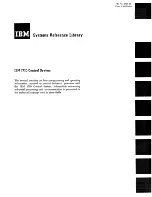
4
Model Code
H - High flow
(06/10 valve size only)
11
Vent Pressure
V
- High vent
Omitted - Standard & low vent models
External drain feature
Y
- Sequence Valve
Omitted - Standard Relief
12
P
- Manual override
(’A’ & ’B’ pilot stage models
only)
1
3
4
6
9
8
7
1
2
8
10
2
3
6
7
Multi-fluid capability
(Viton Seals)
Relief valve
Port connection
G - Manifold or subplate mounted
S - SAE straight thread
T - NPTF Pipe Thread
Spool function
(Pilot stage models only)
13
Valve size
03 - 3/8 inch
06 - 3/4 inch
10 - 1 1/4 inch
Pressure Range
B - 125-1000 PSI
C - 500-2000 PSI
F - 1500-3000 PSI
13
Design
Table 3. Model Code Breakdown
10
11
12
4
Solenoid controlled
(Pilot stage models only)
9
Pilot stage
(Solenoid controlled models only)
A - Spring offset
C - Spring centered
5
5
Section II – Description
A. General
Relief valves are devices used to limit maximum pressure in
hydraulic systems. When system pressure starts to exceed
the pressure setting of the relief valve, a controlled amount of
hydraulic fluid bypasses through the tank port and limits the
system pressure to the valve setting. A fine incremented
adjustment assures precise regulation over wide pressure
ranges.
A Vickers relief valve provides a fast response with very low
pressure override characteristics because of its two-stage
balance piston design. The balance piston relief valve is so
named because in normal operation it is in hydraulic
balance. Further details are discussed in Section III.
B. Basic Parts
Relief valves consist of two sections: the cover section and
the body section. The cover section includes a pressure
adjustment screw, a heavy spring, a poppet, a seat, and a
vent connection. The body section includes a piston, a light
spring, a seat, and the port connections.






























